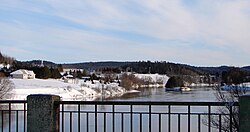Top Qs
Timeline
Chat
Perspective
Lièvre River
River in Quebec, Canada From Wikipedia, the free encyclopedia
Remove ads
The Lièvre River (French: Rivière du Lièvre, pronounced [ʁivjɛʁ dy ljɛvʁ]) is a river in western Quebec which flows south from the Mitchinamécus reservoir and empties into the Ottawa River at Masson-Angers. The river is 330 kilometres (210 mi) long and drains an area of 10,400 square kilometres (4,000 sq mi). The river's name is an adaptation of its former French name Riviere aux Lièvres, "River of the Hares".
The 1908 landslide at Notre-Dame-de-la-Salette and the earlier 1903 clay landslide at Leda both occurred on this river.
At one time, the river was used to transport logs downstream to sawmills located near the river's mouth. In 1928, a paper mill was built near the mouth of the river. On December 18, 1998, this mill was bought from Industries James Maclaren Inc. by private investors and became Papier Masson Ltee. In turn, the White Birch Paper Company bought it in January 2006.[1][2]
There are a number of hydroelectric plants on the river, as well as large and viable deposits of Uranium ore in the district.
The river is the subject of Archibald Lampman's poem "Morning on the Lièvre". The award-winning short film Morning on the Lièvre paired a narration of Lampman's poem with footage of two men canoeing on the river.[3]
Remove ads
Tributaries
- Mitchinamécus River
- Kiamika River
Communities
- Mont-Laurier
- Notre-Dame-de-Pontmain
- Notre-Dame-du-Laus
- Val-des-Bois
- Notre-Dame-de-la-Salette
- Glen Almond (municipality L'Ange-Gardien)
- Buckingham now part of Gatineau
References
Wikiwand - on
Seamless Wikipedia browsing. On steroids.
Remove ads


